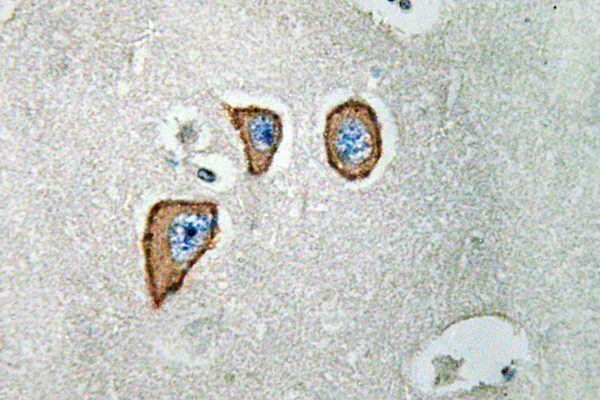NMDAε3 Polyclonal Antibody
- Catalog No.:YT3153
- Applications:IHC;IF;ELISA
- Reactivity:Human;Rat;Mouse;
- Target:
- NMDAε3
- Fields:
- >>Calcium signaling pathway;>>cAMP signaling pathway;>>Neuroactive ligand-receptor interaction;>>Circadian entrainment;>>Long-term potentiation;>>Glutamatergic synapse;>>Alzheimer disease;>>Amyotrophic lateral sclerosis;>>Spinocerebellar ataxia;>>Prion disease;>>Pathways of neurodegeneration - multiple diseases;>>Cocaine addiction;>>Amphetamine addiction;>>Nicotine addiction;>>Alcoholism
- Gene Name:
- GRIN2C
- Protein Name:
- Glutamate [NMDA] receptor subunit epsilon-3
- Human Gene Id:
- 2905
- Human Swiss Prot No:
- Q14957
- Mouse Swiss Prot No:
- Q01098
- Immunogen:
- The antiserum was produced against synthesized peptide derived from human NMDAepsilon3. AA range:937-986
- Specificity:
- NMDAε3 Polyclonal Antibody detects endogenous levels of NMDAε3 protein.
- Formulation:
- Liquid in PBS containing 50% glycerol, 0.5% BSA and 0.02% sodium azide.
- Source:
- Polyclonal, Rabbit,IgG
- Dilution:
- IHC 1:100 - 1:300. ELISA: 1:5000.. IF 1:50-200
- Purification:
- The antibody was affinity-purified from rabbit antiserum by affinity-chromatography using epitope-specific immunogen.
- Concentration:
- 1 mg/ml
- Storage Stability:
- -15°C to -25°C/1 year(Do not lower than -25°C)
- Other Name:
- GRIN2C;NMDAR2C;Glutamate [NMDA] receptor subunit epsilon-3;N-methyl D-aspartate receptor subtype 2C;NMDAR2C;NR2C
- Molecular Weight(Da):
- 134kD
- Background:
- This gene encodes a subunit of the N-methyl-D-aspartate (NMDA) receptor, which is a subtype of ionotropic glutamate receptor. NMDA receptors are found in the central nervous system, are permeable to cations and have an important role in physiological processes such as learning, memory, and synaptic development. The receptor is a tetramer of different subunits (typically heterodimer of subunit 1 with one or more of subunits 2A-D), forming a channel that is permeable to calcium, potassium, and sodium, and whose properties are determined by subunit composition. Alterations in the subunit composition of the receptor are associated with pathophysiological conditions such as Parkinson's disease, Alzheimer's disease, depression, and schizophrenia. Alternative splicing results in multiple transcript variants. [provided by RefSeq, Jun 2013],
- Function:
- function:NMDA receptor subtype of glutamate-gated ion channels with high calcium permeability and voltage-dependent sensitivity to magnesium. Mediated by glycine.,similarity:Belongs to the glutamate-gated ion channel (TC 1.A.10) family.,subunit:Interacts with PDZ domains of INADL and DLG4 (By similarity). Forms heteromeric channel of a zeta subunit (GRIN1), a epsilon subunit (GRIN2A, GRIN2B, GRIN2C or GRIN2D) and a third subunit (GRIN3A or GRIN3B).,tissue specificity:Mainly in brain with predominant expression is in the cerebellum, also present in the hippocampus, amygdala, caudate nucleus, corpus callosum, subthalamic nuclei and thalamus. Detected in the heart, skeletal muscle and pancreas.,
- Subcellular Location:
- Cell membrane ; Multi-pass membrane protein . Cell junction, synapse, postsynaptic cell membrane; Multi-pass membrane protein.
- Expression:
- Mainly expressed in brain with predominant expression is in the cerebellum, also present in the hippocampus, amygdala, caudate nucleus, corpus callosum, subthalamic nuclei and thalamus. Detected in the heart, skeletal muscle and pancreas.
- June 19-2018
- WESTERN IMMUNOBLOTTING PROTOCOL
- June 19-2018
- IMMUNOHISTOCHEMISTRY-PARAFFIN PROTOCOL
- June 19-2018
- IMMUNOFLUORESCENCE PROTOCOL
- September 08-2020
- FLOW-CYTOMEYRT-PROTOCOL
- May 20-2022
- Cell-Based ELISA│解您多样本WB检测之困扰
- July 13-2018
- CELL-BASED-ELISA-PROTOCOL-FOR-ACETYL-PROTEIN
- July 13-2018
- CELL-BASED-ELISA-PROTOCOL-FOR-PHOSPHO-PROTEIN
- July 13-2018
- Antibody-FAQs
- Products Images

- Immunohistochemistry analysis of NMDAε3 antibody in paraffin-embedded human brain tissue.



